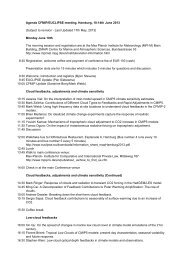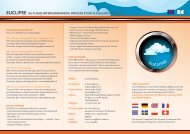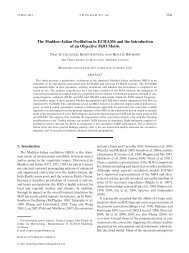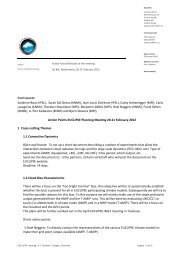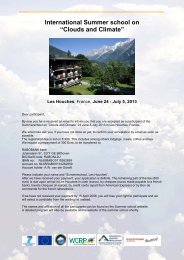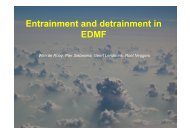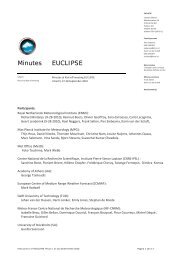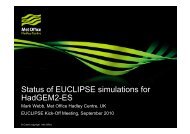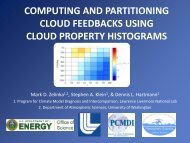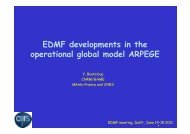EUCLIPSE First Period Report
EUCLIPSE First Period Report
EUCLIPSE First Period Report
Create successful ePaper yourself
Turn your PDF publications into a flip-book with our unique Google optimized e-Paper software.
D3.4 and D3.5 Equilibrium Solutions of SCMs for boundary layer clouds and<br />
identification and comparison of the key quantities used in ESM parameterization<br />
schemes that control the cloud properties (Month 30).<br />
KNMI (Sara Dal Gesso) has been working on generalizing the equilibrium cases of<br />
CGILS for the equilibrium stratocumulus and shallow cumulus case. This<br />
generalisation is accomplished by varying the strength of the inversion jumps and<br />
investigating how the equilibrium solutions of the atmospheric state depend on this.<br />
φ ∈ θ , between 3000<br />
These inversion jumps are represented as the difference of { }<br />
m and the sea surface, where θl denotes the potential liquid water temperature and qt<br />
denotes the total water specific humidity. The reason for this is that the inversion<br />
strength is an important parameter that largely determines the cloud amount of the<br />
equilibrium solution. As an example we show in Figure 15 for a SCM version of EC-<br />
Earth how the liquid water path of the equilibrium solutions varies with the inversion<br />
strength.<br />
Figure 15: The liquid water path(left panel) and the cloud fraction (right panel) for 100<br />
equilibrium runswith a SCM version of EC-Earth are shown in which the inversion<br />
strengths of the humidity and the temperature is varied. The S11 and the S12 case are<br />
indicated as special cases.<br />
It can be seen in Figure 15 that if the temperature jump is decreased the cloud<br />
fraction and the liquid water path is decreasing and a transition from Stratocumulus to<br />
cumulus can be observed. Such a result can be viewed as fingerprint of which<br />
boundary clouds a parameterization scheme produces as a function the inversion<br />
strength. This exercise will be repeated for all SCM version of the ESMs that<br />
participate within <strong>EUCLIPSE</strong> and benchmarked with LES results that can serve as a<br />
benchmark. Also the sensitivity for the used entrainment formulation will be<br />
addressed as well as the response of an increased SST thereby generalizing the CGILS<br />
philosophy to a more complete phase space.<br />
D3.6 Compilation of ESM results at selected grid points (Month 18).<br />
All the ESMs have implemented the appropriate software to have dedicated output at<br />
selected grid points in all the present and future climate ESM runs described in WP1.<br />
l qt<br />
33



